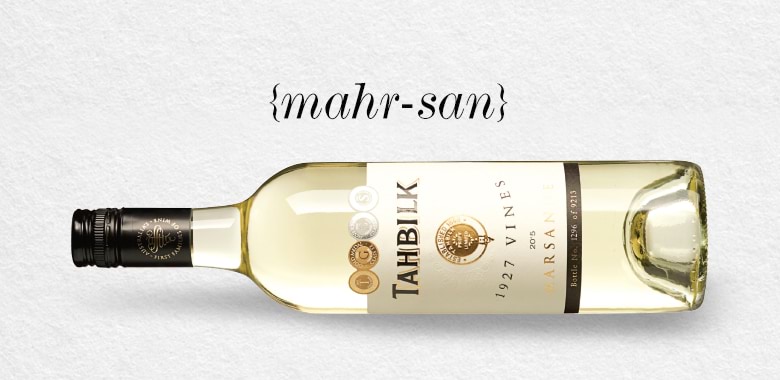
Wine
What is Marsanne?
Marsanne is one of the world’s rarest grape varieties. Its home is France’s Rhône Valley, and it is only grown in three other countries – Switzerland, the USA and Australia.
Marsanne is famous for its role in the winemaking process in the white wines from Hermitage, but it is here in Australia where you will find the largest and oldest single planting of Marsanne in the world.
Shop Marsanne
An infographic guide of Marsanne
Originally from France, Marsanne is a white wine full of character and complexity.
Marsanne thrives in moderate to warm climates and is known for it's lemon, stonefruits, lemongrass, lime and honeysuckle notes.
Pair Marsanne with any seafood dish like shellfish or oysters.
Marsanne is great for ageing and can be cellared for up to 15 years.
Marsanne has a similar body to Chardonnay and is more dry than sweet.
Tahbilk still produces Marsanne from plantings dating back to 1927.
Where is Marsanne Grown In Australia?
Tahbilk in the central Victorian region of Nagambie is the unchallenged king of Marsanne in Australia. In fact, there is no other winery in Australia as strongly tied to a variety.
The Tahbilk Marsanne relationship started in the 1860s with the sourcing of ‘White Hermitage’ cuttings from the ‘St Hubert’s’ Vineyard in Victoria’s Yarra Valley. Those vines didn’t survive, but today Tahbilk still produces Marsanne from plantings dating back to 1927.
Tahbilk Marsanne has a unique ability to age gracefully in the bottle and several older vintages are still providing superb drinking.
Despite Tahbilk’s dominance, some other wineries across the country work with Marsanne with around 60 per cent of Australia’s Marsanne vines planted in the Riverina. Most often Australian Marsanne is blended with other Rhône Valley whites such as Viognier and Roussanne to great success.
It can also be found in tiny amounts in some Shiraz wines, mirroring French co-fermenting practices.
What Makes Marsanne So Special?
Jo Nash, Tahbilk’s General Manager and an expert in Marsanne, explains what makes Tahbilk Marsanne so unique.
Like anything that ages, Marsanne rewards those who offer them time. No two vintages age the same.
The beauty of Tahbilk Marsanne is its versatility and the drinking experience can be strikingly different due to the winemaking style or the age of the wine. The wines are fresh and crisp in their youth, developing complexity and character over time.
- Jo Nash, Tahbilk General Manager
Jo Nash, Tahbilk General Manager
What Is The Quality Of Marsanne In Australia? And How Does This Differ From The Rest Of The World?
Again, we asked Jo Nash to comment on the quality of Australian Marsanne.
At Tahbilk, our Marsanne vines date back to 1927, and are both the largest and oldest plantings in the world.
In addition to mastering the art of harvesting and fermentation over five generations of family ownership, it is the purity of the fruit that gives Tahbilk Marsanne its versatility.
As one of only eight wine regions worldwide, dramatically influenced by inland water mass, our unique environment lies at the heart of our ability to craft Marsanne wines of exceptional quality for generations.
- Jo Nash, Tahbilk General Manager
What Does Marsanne Taste Like?
First, let’s answer one of the most-asked questions – Is Marsanne a sweet wine? Or is Marsanne a dry wine? Marsanne is a dry white wine and has excellent ageing ability.
Marsanne characteristics change as the wine ages. In its youth, Marsanne wine is light in colour and body with a fresh acid backbone. Aromas and flavours of citrus fruits and stone fruits are common alongside the signature character of honeysuckle.
Aged Marsanne will be a deeper colour in the glass with the honeysuckle and stone fruit becoming more apparent. The wine can have a similar body to that of Chardonnay.
Marsanne can handle the influence of oak and these wines show a creamy texture that adds an extra dimension.
What Wine Is Marsanne Similar To?
The ace up its sleeve is its versatility. It can be full of life and energy and offer an alternative to Sauvignon Blanc, Pinot G, Semillon and Riesling. Marsanne wine can also offer mouthfeel and texture and with white wines with texture becoming increasing popular, Marsanne sits in a great position. As it ages Marsanne becomes more similar to Chardonnay.
Are Marsanne Wine And Roussanne Wine The Same?
Marsanne and Roussanne are two different varieties. Marsanne has a unique relationship with Roussanne – they are often blended, with Marsanne giving good weight and structure, and Roussanne adding perfume and flavour.
In fact, DNA research suggests that Marsanne has a parent-offspring relationship with Roussanne.
What Food Pairs Well With Marsanne?
Marsanne wine is very versatile when it comes to food pairing. Younger Marsanne wines with their energy and freshness suit light salads, shellfish and white fish including the delicious dishes and recipes below.
Richer aged Marsanne wines suit richer foods such as roasted poultry, oily fish, creamy pasta and lightly spiced curries. A glass of aged Australian Marsanne will pair perfectly with any of the featured dishes and recipes below.
While it’s super versatile and absolutely delicious, Marsanne remains one of Australia’s most underrated varieties. But because of this, it is also one of the best-value white wines. So, before the word gets out, snap some up and add them to your cellar today.